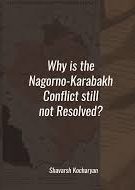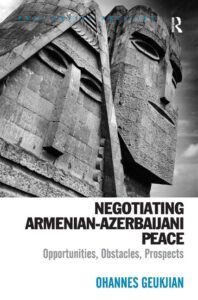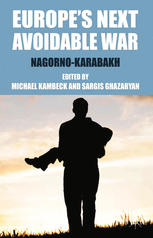Menu
CLOSE
Menu
ՀԱՅԵՐԵՆ
ENGLISH
РУССКИЙ
FRANCAIS
ESPAÑOL
العربي
The AZERBAIJAN-ARTSAKH (Karabakh) CONFLICT
FROM THE MINISTRY OF FOREIGN AFFAIRS OF THE ARTSAKH REPUBLIC
Azerbaijan-Karabakh Conflict
- History of the Conflict
- Artsakh in the Soviet Period
- Artsakh Movement
- Referendum on Independence in 1991
- Armenian pogroms in Azerbaijan
- Koltso Operation
- Azerbaijani aggression
- Mercenaries in the war against Artsakh
- Maragha Massacre
- Four-day War in April 2016
FROM THE MINISTRY OF FOREIGN AFFAIRS OF THE REPUBLIC OF ARMENIA
OTHER RESOURCES
- KarabakhFacts.com: A comprehensive database on Artsakh (Nagorno Karabakh) conflict, compiled by the International and Comparative Law Center (ICLaw Armenia).
BOOKS
 Shahen Avakian, NagornoKarabakh: Legal Aspects, Fourth Edition, Yerevan 2013.
Shahen Avakian, NagornoKarabakh: Legal Aspects, Fourth Edition, Yerevan 2013.
The study covers the legal aspects of Nagorno Karabagh problem. It examines the issues of Law as they affected the legal status of Nagorno Karabagh.
The author is an expert in International Law. He has graduated from the Paris Sorbonne University and is specialized in International Public Law and International Organizations law.
This study is the fourth revised edition and contains additional information and updates. The publications of the earlier editions of this research are also available in Armenian, French, Russian, Arabic and Greek. Shavarsh Kocharyan, Why is the Nagorno Karabakh Conflict Still Not Resolved, Yerevan 2016.
Shavarsh Kocharyan, Why is the Nagorno Karabakh Conflict Still Not Resolved, Yerevan 2016.
Deputy Minister of Foreign Affairs of the Republic of Armenia since 2008. Associate professor at the faculty of International Relations and Diplomacy of the Yerevan State University. A.R.F. Dashnaktsutyun Position Paper, Towards a Fair and Just Resolution – The Mountainous (Nagorno) Karabakh Conflict, November 2010, Yerevan-Stepanakert.
A.R.F. Dashnaktsutyun Position Paper, Towards a Fair and Just Resolution – The Mountainous (Nagorno) Karabakh Conflict, November 2010, Yerevan-Stepanakert.
The political conflict between Mountainous (Nagorno or Upper) Karabakh and Azerbaijan dates back to 1918 when for the first time in history a state named Azerbaijan was founded with the break-up of the Russian Empire. Never in its history has Azerbaijan had sovereignty over the Mountainous Karabakh region. The conflict resumed in 1988 and gradually escalated into an armed confrontation when Azerbaijan responded violently to the peaceful popular quest of the Mountainous (Nagorno) Karabakh Autonomous Region to be reunited with Soviet Armenia. In 1991, the Mountainous Karabakh Republic was founded and it initiated the process of its independence in compliance with the domestic legislation of the USSR and in con for mity with the principles and attributes required by international law for the creation of an independent state.
This is the condensed version of the ARF-Dashnaktsutyun position paper titled “Towards a Fair and Just Resolution: The Mountainous (Nagorno) Karabakh Conflict,” published in September 2010. The complete version of this position paper can be accessed at http://www.arfd.info/wp-content/uploads/2010/10/201009-ARF-KarabakhFile-web1.pdf Ohannes Geukjian, Ethnicity, Nationalism and Conflict in the South Caucasus — Nagorno-Karabakh and the Legacy of Soviet Nationalities Policy. 2012, Routledge, London, 1st Edition.
Ohannes Geukjian, Ethnicity, Nationalism and Conflict in the South Caucasus — Nagorno-Karabakh and the Legacy of Soviet Nationalities Policy. 2012, Routledge, London, 1st Edition.
This book examines the underlying factors of the Nagorno-Karabakh conflict in the South Caucasus from 1905 to 1994, and explores the ways in which issues of ethnicity and nationalism contributed to that conflict. The author examines the historiography and politics of the conflict, and the historical, territorial and ethnic dimensions which contributed to the dynamics of the war. The impact of Soviet policies and structures are also included, pinpointing how they contributed to the development of nationalism and the maintenance of national identities. The book firstly explores the historical development of the Armenian and Azerbaijani national identities and the overlapping claims to the territory of Nagorno-Karabakh. The author goes on to assess the historical link between ethnicity and territorial location as sources of ethnic identification and conflict. He examines how identity differences shaped the relations between Armenians and Azerbaijanis during the different phases of conflict and present a detailed historical account of Soviet nationalities policy and ethno-territorial federalism – the basis of which ethnic relations were conducted between governing and minority nations in the south Caucasus.
This invaluable book offers students and scholars of post-Soviet politics and society a unique insight into the causes and consequences of this long-standing conflict. Ohannes Geukjian, Negotiating Armenian-Azerbaijani Peace: Opportunities, Obstacles, Prospects, Routledge, 2014.
Ohannes Geukjian, Negotiating Armenian-Azerbaijani Peace: Opportunities, Obstacles, Prospects, Routledge, 2014.
Conflict resolution, conflict management, and conflict transformations are major themes in this unique book which examines, explores and analyses the mediation attempts of the Organization for Security and Cooperation in Europe in the Nagorno-Karabakh conflict.
Ohannes Geukjian shows the most striking characteristic of a protracted internal conflict such as this is its asymmetry and explains that, without meeting basic human needs like identity, recognition, security, and participation, resolving any protracted social conflict is very difficult. The Armenian Azerbaijani case demonstrates how official diplomacy may not be able to solve protracted internal conflicts as, without addressing the real causes of the problematic relationship, attempts at peacemaking will always be sporadic and the space for mutual understanding and compromise shrink. Geukjian shows that conflict transformation has particular salience in asymmetric conflicts such as this where the goal is to transform unjust relationships and where a high degree of polarisation between the disputants has taken root.
Using the Nagorno-Karabakh case, this book focuses on the anatomy and causes of deadlock in negotiations and highlights the many difficulties in achieving a breakthrough. Michael Kambeck, Sargis Ghazaryan (eds.), Europe’s Next Avoidable War: Nagorno-Karabakh, 2013, Palgrave Macmillan UK.
Michael Kambeck, Sargis Ghazaryan (eds.), Europe’s Next Avoidable War: Nagorno-Karabakh, 2013, Palgrave Macmillan UK.
An international and interdisciplinary group of experts shed light upon the Nagorno-Karabakh conflict today, how it evolved and likely scenarios. Taking into account a changed political landscape, including the EU’s new foreign policy instruments, they also make concrete policy proposals to make war less likely.“While there are numerous books on the NK conflict, this one stands out from the set in that not only does it comprehensively present the conflict but also, and perhaps more importantly, aims to come up with innovative solutions which would contribute to the conflict settlement.” – European Union Affairs
ARTICLES, PAPERS, SPEECHES, STATEMENTS
- Tigran Martirosyan, Karabakh Conflict: Retrospective Analysis, International Law and Conflict Resolution
- Lusine Sargsyan, Spotlight Karabakh — The Republic of Artsakh
- Anzhela Elibegova, Armenophobia in Azerbaijan: Causes and Effects
- Samvel Martirosyan, Armenia, Azerbaijan and the War on Information
- PolGeoNow, All About Nagorno-Karabakh’s 2017 Name Change
